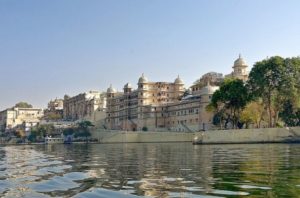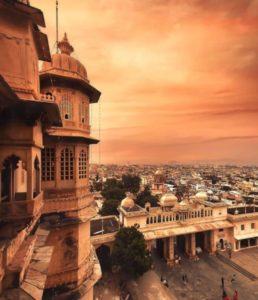Interesting Facts,History & Unique Things About City Palace,Udaipur

- By
- Aparna Patel
- |
- 1 Jan, 2020
- |

Are you looking for lesser-known facts about City Palace,Udaipur? Here is a collection of interesting and unknown facts about City Palace,Udaipur which You’ve Never Heard Before.
Rajasthan is the most royal and wonderful state of India, famous all over the world for its geographical variation, cultural environment, and historical sites. Rajasthan has two city palaces, one is located in Jaipur and the other is located in Udaipur, the most royal city of Rajasthan.The City Palace of Udaipur is quite different from the City Palace in Jaipur,It is built on the top of a hill on the banks of Lake Pichola, from where you can see the beauty entire city. This palace is the largest palace of its kind in Rajasthan.It can be gauged from the fact that its premises consist of 11 palaces.Among these, Dilkhush Mahal, Sheesh Mahal, Mor Chowk, Moti Mahal, and Krishna Vilas are the center of attraction of all.Apart from this, the palace has many domes, courtyards, corridors, rooms, pavilions, towers, and hanging gardens.

Table of Contents
Quick info about City Palace ,Udaipur
- Location– Udaipur, Rajasthan (India)
- Construction Period – 16th century
- Type-palace
- who built the city palace? – Uday Singh II
The City Palace at Udaipur, on the banks of Lake Pichola, is considered the largest royal complex in Rajasthan. This magnificent palace was built by Maharana Uday Singh in the year 1559. Maharana lived and governed the kingdom in this palace.

The palace was then made even more magnificent by his successors, who added several structures to it. The palace now has palaces, courtyards, pavilions, corridors, terraces, rooms, and hanging gardens. There is also a museum that displays some of the finest elements of Rajput art and culture – ranging from colorful paintings to typical architecture found in Rajasthani palaces.
Interesting Facts and Information About City Palace ,Udaipur

- The construction of this world-famous palace was started in the 16th century by Uday Singh II, the famous ruler of Mewar, which was later completed by the king’s son Maharana Pratap.
- This palace was attacked by the rulers of many empires, due to the increasing invasion of Marathas in 1818 AD, the ruler of this place, handed over this fort and area to the British, around 1948 it Was merged into India.
- This palace is one of the highest and largest palaces in India, this palace was built on a 598-meter high plateau, this palace is about 244 meters long and 30.4 meters high.
- This palace was built in the year 1559 AD by the famous Sisodia rulers of Mewar, more than 76 generations of Sisodias contributed to the construction of this palace.
- Uday Singh II made a major contribution to the construction of this palace, who built 11 small separate palaces within it.
- Let me tell you that many films have been shot at City Palace like ‘Guide‘, ‘Goliyon Ki Rasleela Ram-Leela‘ and James Bond film ‘Octopussy‘. The City Palace of Udaipur is a gentle confluence of architectural brilliance and rich heritage.
- This is the largest palace of Rajasthan, it was built by 22 kings.
-
8 sculptures of the City Palace in Paris
The eight years old statues of the City Palace have raised the value of the whole of India in the International Tangible Craft Exhibition held in Paris.
-
Speical Fan
The special thing here is a fan kept in a room. Kerosene is required to run it, not 220 volts current. First oil burns, then its heat creates air pressure.This pressure of air causes some turbine-like fan to rotate and this causes the fan to rotate. Some parts of this palace have been converted into two hotels. Its names are ‘Shiva Niwas Palace’ and ‘Fateh Prakash Palace’, where things made of the crystal can be seen.
10.Structures In City Palace
1. Gateways
The palace has several entrances, beginning with the ‘Bari Pol‘ on the left, ‘Tripolia‘, a triple-arched gate built-in 1725, towards the center and ‘Elephant Pol’ on the right. The main gate of the palace is through Bara Pol which welcomes you to the first courtyard.
This is the place where the Maharanas were weighed with gold and silver, ornaments were distributed among the poor.The doors located in this palace were called “Pol“, the most prominent door of this palace is the “Badi Pol” which leads to the huge courtyard of this palace.’Tripolia Pol’ is a major gate in this palace which is a mixture of 3 arched doors, it was built in the year 1725 AD.
2. Amar Vilas City Palace Udaipur
Amar Vilas is a lofty garden with a wonderful terrace garden full of fountains, towers, terraces, and a square marble tub. Built at the highest level of the palace, it was the place where kings used to spend time. Amar Vilas also gives way to the Badi Mahal.It was built as a pleasure pavilion in the Mughal style.
3. Badi Mahal City Palace Udaipur
Badi Mahal is also known as Garden Palace. The building is made of natural rock which is 27 meters high. Badi Mahal also has a swimming pool that was used during the festival of Holi.
It also has a hall containing miniature paintings of the 18th and 19th centuries, Jag Mandir and Vishnu images of Jagdish temple.
4.Fateh Prakash Palace Udaipur
The Durbar Hall was built within the Fateh Prakash Palace in the year 1909 as a venue for official functions such as state banquets and meetings.
Fateprakash Mahal has now been converted into a hotel. It contains many rare items such as crystal chairs, dressing tables, sofas, tables, chairs and beds, crockery, table fountains, and jewel-studded carpets.
Incidentally, they were never used as Maharana Sajjan Singh ordered these rare items in 1877, but he died before arriving here.
The Items in the Fateh Prakash Palace were ordered by Maharana Sajjan Singh to F&C Osler & Co., London in the year 1877, he died soon after which these items were not used for about 110 years.
5. Durbar Hall City Palace Udaipur
The Durbar Hall is a relatively new extra hall and was built in 1909 as a venue for official functions at the Fateprakash Palace. The hall is decorated with chandeliers and features portraits and weapons of Maharana.
6. Bhim Vilas City Palace Udaipur
This is another gallery with a large collection of paintings depicting Radha and Krishna.
Located in the palace complex, Bhima Vilas is a gallery with a collection of paintings depicting the real-life stories of Radha-Krishna.
7. Chini Chitrashala City Palace Udaipur
A distinctive attraction in this palace is the Chini Chitrasala, which houses a collection of beautiful Chinese and Dutch tiles.
8. Small Chitrashala – Choti Chitrashala City Palace Udaipur
The small gallery is a gallery dedicated to peac**k paintings. Here you will find various beautiful pictures of peac**ks.
9. Krishna Vilas
Krishna Vilas Room also has a wide collection of miniature paintings.
10. Manak Mahal City Palace Udaipur
It was a hall for formal audiences for the Mewar rulers. Here a symbol like the shape of the Sun can be seen.
11. Mor Chowk – Mor Chowk City Palace Udaipur

The chamber is an integral part of the interior of the palace and has a detailed depiction of three peac**ks representing the summer, winter and monsoon seasons. The peac**ks are designed with 5000 pieces of glass, which glow in green, golden and blue colors.
12. Rang Bhawan
It was a royal treasure in the beginning and now houses the temples of Lord Krishna, Meera Bai, and Shiva.
13. Sheesh Mahal
The Sheesh Mahal, also known as the Palace of Mirrors, was built by Maharana Pratap in 1716 for his wife.
14. City Palace Museum
The Ladies Chamber or ‘Zenana Mahal’ has been converted into a museum for the public.
15.”Janana Mahal”
In the year 1974 AD, one of the most beautiful palaces of this palace complex, “Janana Mahal” (Ladies Chamber) was converted into a museum.
16. “Janana Mahal” for Destination Wedding –
Many royal weddings have been held at the City Palace. All these weddings are held in the Zanana Mahal of the City Palace. This palace is a major part of the Udaipur City Palace. The palace was built in the 1600s and there have been countless royal weddings since then. Zanana Mahal has seating for 500 guests. At night, Zenana Mahal shines in the light of candles. Many billionaires of the country book Zenana Mahal for the Royal Wedding. Decoration charges start from 6 lakhs to 35 lakhs.
City Palace Udaipur History
Mewar kingdom was being expanded in Nagda, which was founded by Maharana Guhil, the first of Mewar in 568 AD. In the 8th century, the state capital was shifted to Chittor, where Sisodia Rajputs ruled for almost 80 years.
In 1537, Maharana Udai Singh II re-established the Mewar Empire, but over time he was losing control of the fort during the war with the Mughal Empire.

As a result, Uday Singh II was decided to build his new empire on the banks of Pichola Sarovar.This place was surrounded by forests from all directions. He was decided to make this place as the new capital.
The ancient royal structure was built as the royal courtyard (Rai Aangan) and from there the structure of a huge City Palace was started.After Uday Singh’s death in 1572, his son Maharana Pratap took over the reins of Udaipur.
He was defeated by Emperor Akbar in the Battle of Haldighati in 1576 and Udaipur went into the possession of the Mughals.
After Akbar’s death, Mewar was again handed over to Amar Singh I, son and successor of Maharana Pratap. Jahangir gave the throne of Mewar to Amar Singh.The Mughal Empire’s army had also tried to launch a campaign against the Mewar Empire, which ended with a peace agreement between the two rulers.
But due to the increasing invasion of Marathas in 1761, the states of Udaipur and Mewar get on the verge of collapsing.Evidence of Maratha attacks after 1761 in Udaipur can still be seen in the ruins there.
From 1818, Maharana Bhim Singh signed a treaty with the British, in which it was written that the British authorities would assist them against other rulers.After the independence of India in 1947, along with the Mewar Empire in 1949, the other princely states merged into democratic India. After this, the king of Mewar also had to lose his royal authority and his royal post.After that, The successors of the Maharana maintained their authority over the palace and developed the palace complex as the Heritage Hotel.
Best Time to Visit City Palace, Udaipur
October to March is a good time to visit the City Palace. Most tourists prefer winter days to visit here. By reaching Udaipur, you can roam the City Palace from 9:30 am to 5:30 pm.
How to Reach City Palace, Udaipur
The City Palace is located in Udaipur, so first, you have to come to Udaipur. The palace is fully connected to the city and other parts of the state.
If you want to travel to Udaipur by flight, the nearest airport is Dabok which is located in Udaipur itself. From this airport, one can take a private taxi or shared taxi to City Palace Udaipur.
If you know any new things about City Palace Udaipur, then definitely tell through the comments so that other people can read,thanks.
Search Posts
Latest posts
-
5 Mar, 2024
How to avoid drinking vodka?
Popular posts
-
5 Mar, 2024
Why prohibit engine braking?